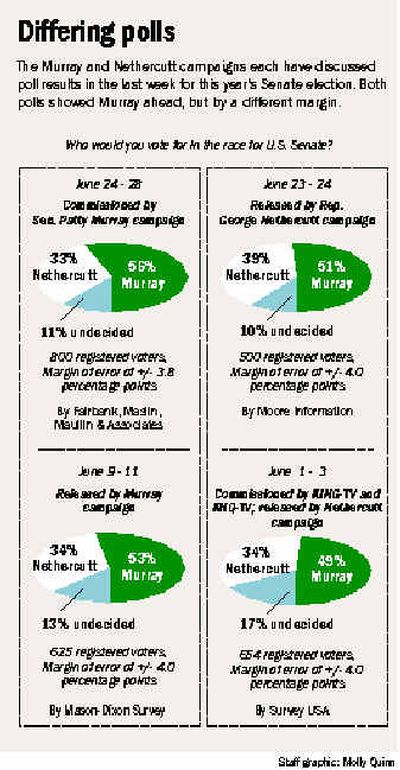Poll shows Murray gaining strength over Nethercutt

In the numbers game that a U.S. Senate race sometimes becomes, incumbent Patty Murray had much better numbers than challenger George Nethercutt on Wednesday.
That’s a change from last week, when her numbers were better than his, but not quite as good as this week’s figures.
All of this is according to polls of potential voters who were asked the standard question: If the election were held today, for whom would you vote in Washington’s Senate race?
According to Murray’s pollster John Fairbank, if the election were held last week – instead of Nov. 2, when it will be – Murray would have collected about 56 percent of the vote, swamping Nethercutt, who would have received about a third of the vote.
Republican House member Nethercutt is having trouble “breaking through” to catch voters’ attention amid their concerns about such things as terrorism and Iraq, Fairbank said. The same poll, conducted after President Bush visited the state and campaigned in Spokane with Nethercutt, showed Bush trailing Democratic challenger John Kerry among Washington voters by 8 percent, he added.
It also showed that half of those surveyed thought taking military action in Iraq was “not the right thing to do” and 57 percent thought the war was “not worth the toll in human lives and other costs.”
Nethercutt voted in favor of the congressional resolution supporting the war in Iraq, while Murray voted against it. After the war started, both voted for an $87 billion appropriation to fund the war.
The kind of lead Murray has is unlikely to last, Fairbank added. “We expect Mr. Nethercutt to close the gap a little bit,” he told reporters in a telephone press conference arranged by the Murray campaign.
Republicans were contending last week that Nethercutt already started to close the gap. During a visit to the state, GOP National Chairman Ed Gillespie was touting a poll that showed Murray with 51 percent and Nethercutt with 39 percent. That survey was conducted by Moore Information of Portland, which regularly works for Republicans.
Even though that’s still a 12 percent spread – with Murray collecting more than half the votes – Gillespie said the Moore poll survey showed Nethercutt had momentum.
“We’re catching her,” the Spokane Republican said in an audio clip sent by e-mail to reporters around the state.
Earlier in June, a poll conducted by Mason-Dixon, an independent firm, showed Murray ahead 52 percent to 34 percent. The Murray campaign sent those numbers to reporters.
A poll conducted by Survey USA for KHQ-TV in Spokane and KING-TV in Seattle showed Murray at 49 percent and Nethercutt at 34 percent.
Although that’s a 15-point gap, the Nethercutt campaign sent it out to any reporters who might have missed it because it showed the incumbent with less than half the votes.
On Wednesday, Nethercutt spokesman Alex Conant downplayed Murray’s latest numbers, contending that they were doing well in more important areas, such as signing up volunteers, garnering favorable press coverage and raising the money a challenger needs to take on an incumbent.
“I don’t put much stock in their polls, just like they probably don’t put much stock in our polls,” Conant said. “Each campaign’s going to tout their own good news.”
Voters who don’t live and breathe such campaign minutiae might wonder how the candidates’ support among voters can vary as much as 10 percentage points over the course of a month.
Del Ali of Research 2000, who has polled in Washington state for more than a decade for The Spokesman-Review, said the various poll results are actually very close.
Each has a margin of error that means the same poll conducted at the same time with different people could produce higher or lower results for each candidate.
Polls don’t predict the outcomes of elections, Ali added, they just produce a snapshot of public opinion at the time they are conducted.
Candidate commercials, news coverage or large campaign events, such as the visit of a president, can all affect that snapshot, he said.